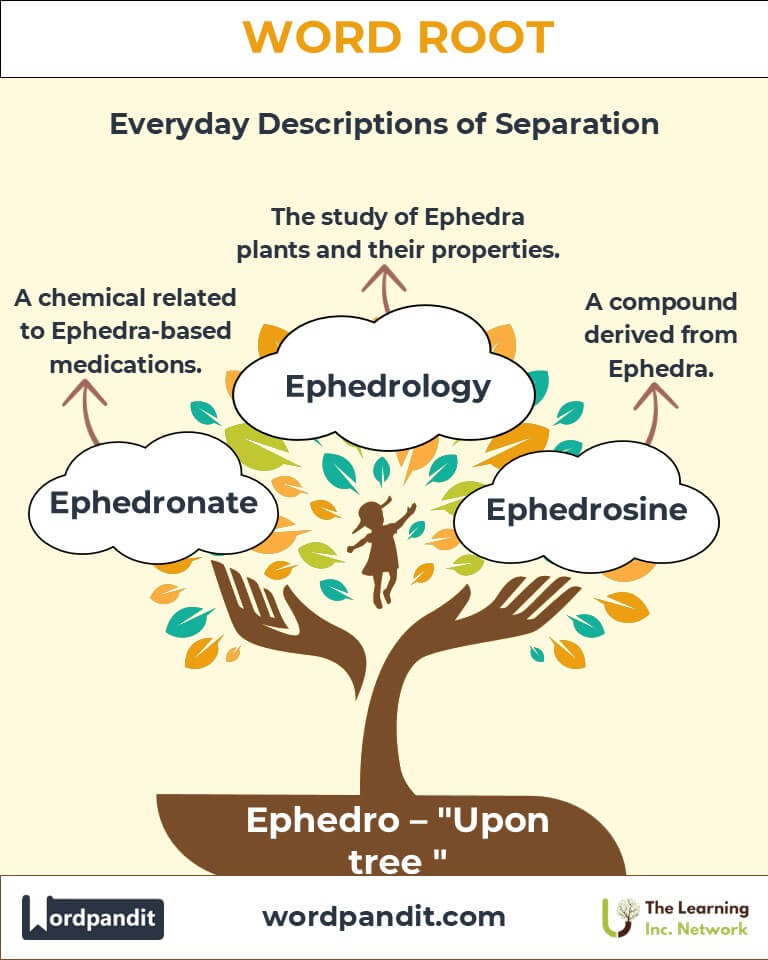Ephedro: A Rooted Connection to Nature and Healing
Discover the significance of the root "Ephedro", derived from Greek, meaning "upon tree." From ancient uses of Ephedra plants to modern medicinal breakthroughs like Ephedrine, this root unveils a story of resilience, growth, and innovation.

Table of Contents
- Introduction: The Essence of "Ephedro"
- Etymology and Historical Journey
- Mnemonic: Unlocking the Power of "Ephedro"
- Common Ephedro-Related Terms
- "Ephedro" Through Time
- "Ephedro" in Specialized Fields
- Illustrative Story: "Ephedro" in Action
- Cultural Significance of "Ephedro"
- The "Ephedro" Family Tree
- FAQs about the "Ephedro" Word Root
- Test Your Knowledge: "Ephedro" Mastery Quiz
- Conclusion: The Living Legacy of "Ephedro"
Introduction: The Essence of "Ephedro"
The root "Ephedro" (pronounced eh-FEE-droh) paints vivid imagery of plants thriving on or near trees. It stems from the Greek phrase meaning "upon tree" and serves as a foundation for words and concepts linked to nature, resilience, and healing. From the ancient use of Ephedra plants in traditional medicine to ephedrine's impact on modern pharmacology, this root showcases the symbiotic relationship between humans and flora.

Etymology and Historical Journey
The word root "Ephedro" originates from the Greek words epi (upon) and dendron (tree). Ancient botanists observed the Ephedra plant clinging to trees, coining the term to reflect its unique habitat. Over centuries, this root became associated with resilience and health, especially as Ephedra gained prominence in traditional Chinese medicine and other healing systems. By the 20th century, scientists extracted ephedrine, revolutionizing treatments for respiratory ailments.
Mnemonic: Unlocking the Power of "Ephedro"
Picture a tree with lush green vines of Ephedra weaving through its branches, symbolizing growth and strength. This imagery captures the root’s meaning and its connection to vitality.
Mnemonic Device: “Ephedro thrives ‘upon the tree,’ bringing nature’s healing to humanity.”
Common Ephedro-Related Terms
- Ephedra (eh-FEH-druh): A genus of plants used in traditional medicine for respiratory issues.
Example: "The herbalist prepared a tea using dried Ephedra leaves to relieve her patient’s cold symptoms." - Ephedrine (eh-FEH-dreen): An alkaloid derived from Ephedra, used in treating asthma and nasal congestion.
Example: "The doctor prescribed ephedrine to alleviate the patient’s breathing difficulties." - Ephedraceae (eh-FED-ruh-see-eye): A plant family characterized by shrubby, jointed-stem plants.
Example: "Ephedraceae species are adapted to arid climates, showcasing remarkable resilience." - Ephedrosis (eh-FEH-droh-sis): Excessive sweating, historically linked to Ephedra-based treatments.
Example: "The herbal remedy triggered mild ephedrosis, an expected side effect."
"Ephedro" Through Time
- Ephedra in Ancient Medicine: Early records from China and India highlight its use for asthma and colds.
- Modern Discovery of Ephedrine: In the 1920s, ephedrine was synthesized from Ephedra, marking a breakthrough in pharmacology.
"Ephedro" in Specialized Fields
- Medicine: Ephedrine is widely used to treat asthma, low blood pressure, and nasal congestion.
- Botany: Studies of Ephedra focus on its drought-resistant properties and ecological adaptations.
- Pharmacology: Synthetic ephedrine derivatives form the basis for modern decongestants.
Illustrative Story: "Ephedro" in Action
In a remote Himalayan village, an herbalist named Arjun brewed a traditional remedy using Ephedra leaves to treat a traveler’s severe cold. The tea eased her symptoms and restored her energy for the journey ahead. Centuries later, scientists studying similar plants isolated ephedrine, transforming traditional wisdom into life-saving modern treatments.
Cultural Significance of "Ephedro"
Ephedra's role in ancient healing practices underscores humanity’s reliance on nature for health. Its cultural resonance is evident in traditional Chinese medicine, where it symbolizes vitality and balance. Today, it bridges ancient and modern knowledge, exemplifying sustainable medical advancements.

The "Ephedro" Family Tree
- Epi- (Greek: upon): Example: Epidermis (outer layer of skin).
- Dendro- (Greek: tree): Example: Dendrology (study of trees).
- Phyto- (Greek: plant): Example: Phytotherapy (plant-based medicine).
FAQs About the Ephedro Root
Q: What does "Ephedro" mean?
A: "Ephedro" means "upon tree," derived from the Greek words epi (upon) and dendron (tree). This root reflects the plant’s association with growing near or on trees, emphasizing its ecological significance and symbiotic relationship with its environment.
Q: What is Ephedra, and why is it important?
A: Ephedra is a genus of plants that thrive in arid and semi-arid regions. Known for their jointed, shrub-like stems, these plants have been used in traditional medicine for centuries, particularly in treating respiratory ailments such as asthma and colds. Their significance lies in their adaptability and their role as a source of ephedrine, a groundbreaking compound in modern medicine.
Q: How does ephedrine relate to Ephedra?
A: Ephedrine is an alkaloid extracted from Ephedra plants. It functions as a stimulant and decongestant, widely used to treat conditions like asthma, low blood pressure, and nasal congestion. Its discovery highlighted the medicinal potential of plants and bridged traditional herbal knowledge with modern pharmacology.
Q: What is the Ephedraceae family?
A: The Ephedraceae family includes shrub-like plants characterized by their drought-resistant properties and unique, jointed stems. These plants are well-suited for harsh, arid climates and provide insights into ecological survival strategies.
Q: What is ephedrosis, and how is it connected to Ephedra?
A: Ephedrosis refers to excessive sweating. Historically, it has been associated with the physiological effects of Ephedra-based remedies, which stimulate the nervous system and can lead to such reactions. While sometimes seen as a side effect, it also underscores the plant's potent biological activity.
Q: Why are Ephedra plants called "living fossils"?
A: Ephedra plants are often referred to as "living fossils" because they are ancient, dating back to prehistoric times, and have remained relatively unchanged in structure. They provide valuable information about plant evolution and resilience.
Q: Can Ephedra plants survive extreme climates?
A: Yes, Ephedra plants are highly adapted to arid and semi-arid climates. Their jointed stems and deep-root systems allow them to conserve water and thrive in harsh environments, making them ecological symbols of resilience.
Q: What role does Ephedra play in traditional Chinese medicine?
A: In traditional Chinese medicine, Ephedra (known as Ma Huang) is used to treat respiratory conditions like asthma and bronchitis, as well as to promote sweating during fevers. Its role highlights the long-standing cultural importance of medicinal plants.
Q: Is Ephedrine safe for regular use?
A: While ephedrine is effective in treating specific medical conditions, its misuse or overuse can lead to side effects such as increased heart rate, high blood pressure, and anxiety. It is crucial to use ephedrine under medical supervision.
Q: Why is "Ephedro" significant in modern medicine?
A: "Ephedro" represents the integration of ancient botanical knowledge with modern medical advancements. The discovery of ephedrine from Ephedra plants revolutionized treatments for respiratory ailments and paved the way for further exploration of plant-based medicines.
Test Your Knowledge: Ephedro Mastery Quiz
1. What does the root "Ephedro" mean?
2. Which plant is associated with the root "Ephedro"?
3. What is ephedrine used for?
4. What is the primary habitat of Ephedra plants?
5. What does ephedrosis describe?
Conclusion: The Living Legacy of "Ephedro"
The root "Ephedro" intertwines nature’s resilience with human innovation. From Ephedra's traditional uses to ephedrine's modern applications, it represents a bridge between ancient wisdom and scientific progress. As we explore sustainable remedies, the "Ephedro" root reminds us of the healing potential rooted in our natural world.












